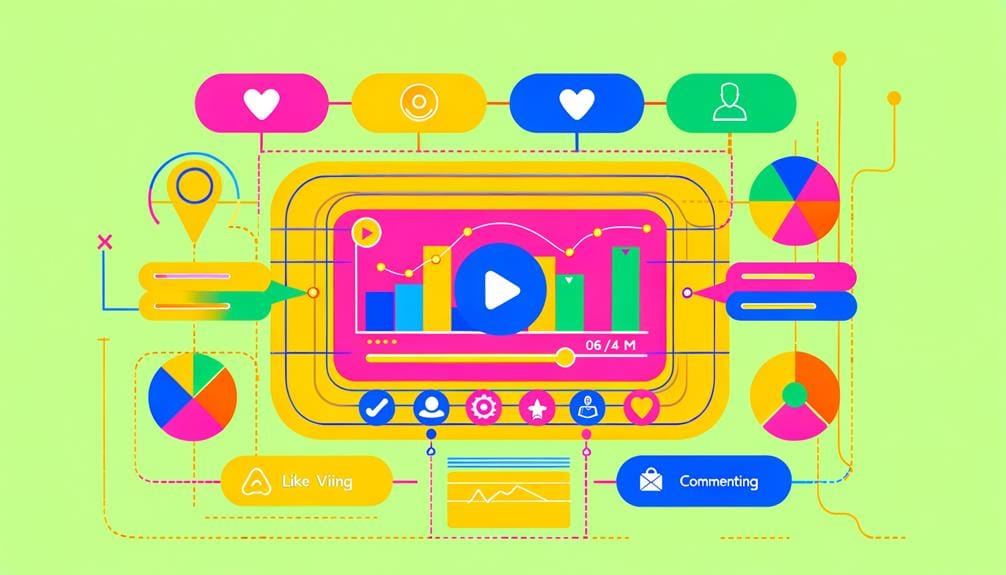Boost your video's search engine visibility with effective semantic SEO tactics. Start by optimizing your titles and descriptions with relevant keywords. Use schema markup like VideoObject to enhance visibility and click-through rates. Don't forget to include transcripts to make your content more accessible and improve discoverability. Craft metadata that aligns with user intent to drive engagement. Keep an eye on metrics like views and watch time to fine-tune your strategy. Ensure your metadata adapts to algorithm changes for continued relevance. Discover more ways to enhance your video SEO and maximize reach.
Key Takeaways
- Use schema markup like VideoObject schema to enhance video visibility in search results.
- Optimize video metadata with concise, keyword-rich titles, descriptions, and tags.
- Index transcripts to improve discoverability and reach international audiences.
- Align video content and metadata with user intent for higher engagement.
- Regularly update metadata to maintain accuracy and visibility in evolving search results.
Understanding Semantic SEO
Understanding semantic SEO means you'll frequently need to optimize your video's metadata, transcripts, and descriptions to align with user intent and improve search engine visibility. Semantic SEO for video content isn't just about keywords; it's about ensuring your videos are contextually relevant and meet the needs of your audience.
By focusing on user intent, you'll provide valuable content that directly answers search queries, enhancing user experience and engagement.
Utilizing schema markup for video content can significantly boost your video's visibility. Schema markup helps search engines understand the context and relevance of your videos, making it easier for them to be indexed correctly.
This approach highlights the importance of topics, entities, and context in your video content, ensuring it resonates with what users are looking for.
Optimizing video metadata is crucial. Effective metadata includes titles, descriptions, and tags that accurately reflect the video's content and its relevance to user queries.
Additionally, detailed transcripts improve accessibility and provide more context, helping search engines better understand your video's message.
Optimizing Video Titles

Crafting effective video titles is essential for attracting viewers and boosting your content's search engine rankings. To optimize your video titles for SEO, start by incorporating relevant keywords. These keywords should be naturally embedded to maintain semantic and contextual relevance, which helps search engines understand your content better and improves search engine visibility.
Including numbers, power words, and emotional triggers can significantly enhance your click-through rates. For instance, titles like 'Top 5 SEO Tips for Beginners' or 'Unlock Unexpected Video SEO Secrets' are likely to capture attention and encourage clicks. However, avoid clickbait; misleading titles can erode viewer trust and negatively impact your channel's reputation.
A/B testing is a valuable strategy for optimizing video titles. Experiment with different variations to see which ones resonate most with your audience. This data-driven approach allows you to refine your titles based on real performance metrics.
Ensure your video titles are concise and descriptive. Ideally, they should be under 60 characters to avoid truncation in search results. By naturally incorporating target keywords and focusing on semantic relevance, you'll not only attract more viewers but also improve your content's overall SEO performance.
Crafting Descriptive Metadata
Descriptive metadata plays a crucial role in enhancing your video's visibility by providing search engines with clear, keyword-rich information about your content. By crafting descriptive metadata, you're leveraging semantic SEO to ensure search engines understand the context of your video content. This includes creating titles, descriptions, tags, and categories that are not only relevant but also packed with accurate descriptions and relevant keywords.
Optimizing metadata isn't just about stuffing keywords; it's about striking a balance between informativeness and search engine friendliness. When you include clear and accurate descriptions, you provide both search engines and your target audience with essential information, boosting your video's visibility in relevant search results.
Here's a quick breakdown to guide you:
| Metadata Type | Importance | Best Practices |
|---|---|---|
| Title | High | Include primary keyword and keep it concise. |
| Description | Medium | Use a detailed summary with secondary keywords. |
| Tags | Medium | Add specific and broad tags for better reach. |
Utilizing Structured Data

When you implement schema markup for your video content, you're enhancing its visibility and boosting search engine rankings.
By enabling rich snippets and video carousels, you attract more user attention and improve click-through rates.
Utilize JSON-LD or Microdata formats to ensure your videos are accurately indexed and displayed, driving organic traffic and improving the user experience.
Schema Markup Implementation
To boost your video content's visibility and engagement, implementing schema markup is essential for providing search engines with clear, structured data. Schema markup, a form of structured data, helps search engines understand your video's content, leading to rich snippets and enhanced visibility in search results. By including details like video duration, upload date, and thumbnail image, your video content becomes more attractive in search listings.
Structured data plays a crucial role in making your video content stand out. When search engines can easily interpret the information on your pages, they're more likely to display rich snippets. These rich snippets not only enhance visibility but also significantly improve click-through rates. With higher click-through rates, your video content attracts more viewers, boosting overall user engagement.
Incorporating schema markup into your SEO strategy is a data-driven approach to optimizing your video content. It ensures that search engines have all the necessary context to accurately index and present your videos. This implementation isn't just about following trends; it's about leveraging structured data to solidify your position in search results.
Start integrating schema markup today and watch your video content gain the visibility and engagement it deserves.
Enhancing Video Rich Snippets
Leveraging schema markup to enhance video rich snippets can significantly boost your video's visibility and engagement by ensuring search engines present optimized, visually appealing snippets. By using structured data markup, you can provide search engines with detailed information about your video content, such as title, description, duration, thumbnail URL, and upload date. This level of detail enhances search engine understanding and leads to more accurate indexing and display.
Using schema markup, like the VideoObject schema, is crucial. It enables search engines to display rich snippets featuring video thumbnails, ratings, and views, which can lead to higher click-through rates and improved user engagement.
Here's how you can make the most of structured data for your video content:
- Include Detailed Descriptions: Provide comprehensive descriptions with relevant keywords to improve search engine understanding.
- Utilize VideoObject Schema: Implement this schema to ensure your videos appear with rich snippets in search results.
- Add Thumbnail URLs: Ensure your videos have eye-catching thumbnails to increase visual appeal.
- Update Metadata Regularly: Keep your structured data up-to-date to maintain accuracy and relevancy.
Boosting Search Visibility
Structured data markup is your ticket to boosting video search visibility and getting featured in Google's coveted video carousel. By implementing structured data markup, you're providing search engines with detailed context and information about your videos, which significantly enhances video content visibility in search results.
Utilizing schema markup for your video content helps search engines understand what your videos are about, leading to higher chances of appearing in featured snippets and rich results. This targeted approach to semantic SEO makes your content more discoverable and appealing to users.
When your videos appear in Google's video carousel, they're front and center, capturing more user attention. Rich snippets generated by structured data can increase your click-through rate (CTR) because they make your videos more informative and enticing at a glance. This not only drives more traffic but also improves the overall user experience by providing additional insights before users click through to watch.
Incorporating structured data markup is a crucial step in a comprehensive SEO strategy. It's a data-driven, user-centric approach that ensures your videos stand out in search results, ultimately driving higher engagement and better performance.
Leveraging Video Transcripts

By integrating video transcripts into your content strategy, you not only enhance accessibility for hearing-impaired users but also significantly boost your SEO efforts. Video transcripts act as a valuable asset for SEO content by providing search engines with text to index. This helps search engines better understand your video content, leading to improved Google search results.
With semantic SEO, video transcripts offer context-rich keywords that can enhance your content's relevance and visibility. Moreover, they allow international audiences to engage with your content through written translations, broadening your reach and improving user accessibility.
Here's how leveraging video transcripts can benefit your strategy:
- Boost SEO: Search engines can index your transcripts, making your video content more discoverable.
- User Accessibility: Transcripts provide a written version of the spoken content, aiding users with hearing impairments.
- International Audiences: Written translations help non-native speakers understand your video content.
- Repurposing Content: Transcripts can be turned into blog posts or articles, maximizing your reach and user engagement.
Incorporating video transcripts into your strategy is a data-driven, user-centric approach that can significantly improve your SEO content, making it more accessible and engaging for a diverse audience.
Enhancing User Engagement

In order to enhance user engagement, integrating interactive elements like quizzes, polls, and clickable links into your video content can significantly boost viewer interaction and retention. These interactive elements not only keep viewers engaged but also contribute to higher engagement rates and better semantic SEO.
Data shows that video content generates 66% more qualified leads and improves user engagement by 300% compared to text-based content. Additionally, videos under 2 minutes long have the highest engagement rates, with 59% of viewers more likely to watch a video entirely. Including video on a landing page can increase conversion rates by 80%, reflecting how engaging content can drive user retention.
Here's a quick breakdown of the impact of different factors on user engagement:
| Factor | Impact | Statistical Data |
|---|---|---|
| Video Content | Boosts user engagement | 300% increase over text-based content |
| Video Length | Higher engagement rates | 59% viewers watch videos under 2 mins |
| Interactive Elements | Encourages user interaction | Enhances engagement and retention |
Aligning With User Intent

To effectively align your video content with user intent, you need to understand the specific queries and needs of your target audience. This understanding starts with analyzing user behavior and preferences to uncover what they're searching for and what kind of information they expect.
By focusing on user intent, you can ensure your video content answers the exact questions your audience is asking. Here's how to align your video content with user intent:
- Analyze search queries: Look at the specific terms and phrases users are typing into search engines. Tools like Google Analytics and Search Console can help identify these.
- Understand user behavior: Study how users interact with your content. Are they watching your videos to the end? Are they engaging with your calls to action? This data is crucial for tailoring your content.
- Provide relevant information: Ensure your videos deliver the valuable information users are looking for. This will keep them engaged and improve your content's relevance.
- Optimize video elements: Use user-centric keywords in your video titles, descriptions, and tags to improve search visibility.
Monitoring Search Performance

Tracking your video's search performance is crucial for understanding how well your content resonates with your audience and search engines. By leveraging tools like YouTube Analytics and Google Search Console, you can gain insights into key metrics that reflect your video content performance. Metrics such as views, watch time, engagement, and click-through rates offer a comprehensive view of audience behavior.
Utilizing these tools lets you identify top-performing videos, keywords, and search queries, which are essential for optimizing your video content. Regularly reviewing search performance data helps you measure the impact of your semantic SEO tactics on search rankings and visibility.
Here's a quick reference table to guide your tracking:
| Metric | Tool | Purpose |
|---|---|---|
| Views | YouTube Analytics | Assess video popularity |
| Watch Time | YouTube Analytics | Understand engagement levels |
| Engagement | YouTube Analytics | Measure likes, shares, comments |
| Click-Through Rate | Google Search Console | Evaluate thumbnail and title efficacy |
| Search Queries | Google Search Console | Identify keywords driving traffic |
Adapting to Algorithm Changes

Adapting to algorithm changes like Google's BERT update means you need to prioritize semantic understanding in your video content.
Focus on adjusting your keyword strategy to include relevant semantic keywords and optimize your metadata to align with user intent.
These tactics will enhance user experience, reduce bounce rates, and boost your search engine rankings.
Algorithm Update Impacts
Staying ahead of algorithm updates like Google's BERT is crucial for ensuring your video content remains visible and relevant in search rankings. BERT, which focuses on understanding the context and intent behind search queries, has made semantic SEO more important than ever.
To maintain and improve your video content rankings, you need to adapt to these algorithm changes by providing relevant information and enhancing user engagement.
Adapting to algorithm updates involves:
- Staying Informed: Keep up with the latest industry trends and best practices related to algorithm updates.
- Contextual Relevance: Ensure your video content aligns with the context and intent of user search queries.
- Enhanced Metadata: Use descriptive titles, tags, and captions that reflect the content's intent and relevance.
- User Engagement: Focus on creating valuable and engaging content that retains users and encourages interaction.
Keyword Strategy Adjustments
To optimize your video content for Google's evolving algorithms, prioritize user intent by incorporating long-tail keywords and conversational phrases. The BERT update emphasizes understanding natural language processing (NLP), making it crucial to align your keyword strategy adjustments with these changes. This means focusing on how users naturally phrase their queries and ensuring your video content reflects this language.
Start by using tools like Google Trends and keyword research platforms to identify trending topics. These tools will help you discover long-tail keywords that match user intent. For example, if your video is about 'DIY home repairs,' consider including conversational phrases like 'how to fix a leaky faucet' or 'easy home repair tips.'
Next, enrich your video titles, descriptions, and transcripts with semantically related keywords. This isn't just about stuffing keywords but about creating content that provides value and answers user queries effectively. By doing so, you enhance your video's visibility on semantic search engines.
Lastly, monitor performance metrics to fine-tune your strategy. Analyzing data will guide your semantic SEO optimization efforts, ensuring your keyword strategy adjustments are effective and aligned with algorithm changes. This approach will keep your video content relevant and easily discoverable.
Metadata Optimization Tips
Regularly updating your video metadata ensures your content remains relevant and highly visible in search results, even as algorithms evolve. By fine-tuning your SEO strategy to include semantic keywords and aligning your video metadata with user intent, you can significantly boost your video's discoverability and engagement.
To stay ahead of algorithm changes and make the most out of metadata optimization, consider these tips:
- Optimize Titles and Descriptions: Use trending topics and relevant search queries to craft compelling titles and descriptions that capture user intent.
- Incorporate Semantic Keywords: Integrate related terms and phrases that enhance the context and relevance of your video content.
- Tag Strategically: Choose tags that reflect both the primary and secondary themes of your video, aiding the YouTube recommendation system in understanding your content.
- Monitor Algorithm Changes: Stay updated with the latest algorithm changes on platforms like YouTube to adjust your metadata accordingly for sustained visibility.
Frequently Asked Questions
How Do You Optimize a Video for Seo?
To optimize a video for SEO, start with thorough keyword research. Focus on title optimization and meta descriptions. Use video transcriptions and closed captions. Design engaging thumbnails, create video sitemaps, and boost social sharing and engagement metrics.
How Do I Optimize My Content for Semantic Seo?
To optimize your content for semantic SEO, focus on keyword research, use natural language, and align with user intent. Structure content with topic clusters, related keywords, and schema markup. Optimize meta descriptions to match search queries.
Is Video Content Good for Seo?
Coincidentally, video content's fantastic for SEO. With compelling video thumbnails, increased viewer engagement, shares on social media, and relevant content, you're boosting watch time and user experience. Optimize video length, keyword placement, and mobile compatibility for best results.
What Is Semantic SEO Strategy?
A semantic SEO strategy involves keyword research, understanding user intent, entity recognition, and topic modeling. You'll optimize content clusters, query semantics, metadata, and rich snippets, and use ontology mapping to boost search rankings and user engagement.
Conclusion
So, you've mastered semantic SEO for video content. Congratulations, you're now a digital wizard!
Just remember, optimizing video titles and crafting metadata isn't rocket science. And don't forget those video transcripts—they're pure gold!
Keep aligning with user intent and monitoring search performance because, you know, the algorithm gods demand it.
Stay data-driven, user-centric, and always ready to adapt.
After all, it's not like SEO is an ever-changing labyrinth designed to keep you on your toes, right?

